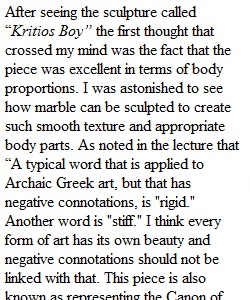


Q The Kritios Boy has been described as "the first beautiful nude in art," and is a precursor to the later Classical sculptures of athletes. Based on what you have learned about periods of Greek sculpture, write a short entry on what period of sculpture you believe he belongs to: Archaic, Classical, or Hellenistic. List the characteristics of this sculpture that led you to make this decision. Specifically, this means naming traits you see in this piece, and comparing/contrasting those traits to what you have seen in the examples we looked at previously, in order to illustrate what is similar and what is different. Cite those examples by name (i.e., "Kritios Boy is similar to the Doryphoros/Demosthenes/Old Market Lady in this way . . . / different in this way . . . "). Challenge yourself to describe this piece using rich, specific language. No Googling allowed! Also, beware of "shorthand" descriptions and easy catch-phrases. You can do this by taking your time and describing the piece in your own words. This is an opportunity for you to think through what you have learned and apply it to what you see. You will be assessed based on your discussion of the object, not on whether you selected the correct time period. Think of a math class, where the point is not just to get the right answer, but to show your work. We are as interested in seeing how you arrive at your conclusions as the conclusions themselves. Important note! Finally, this is an important point that we will return to throughout the term: describe this, and all pieces we study, using terminology that is positive or neutral in its connotations. A typical word that is applied to Archaic Greek art, but that has negative connotations, is "rigid." Another word is "stiff." We are asking you to allow yourself to come up with alternative ways of describing things so that words with negative connotations can be eliminated, and to come up with words that are more neutral or positive. Look at the videos in which Anthony describes Archaic and other first-phase art works, and notice the kind of terminology he employs. "Symmetrical" is less negative than "stiff"; and actually, symmetrical says more than stiff does, in a formal sense. Here, we encourage you to think of how a scientist might describe the sun rising or setting. It's not so important whether the scientist likes or dislikes the fact that the sun appears to rise and set, but it's crucially important that the scientist can describe HOW this works, with rich, specific, detailed language. Think of it this way: You're articulating how and why something works the way it does, not whether you like it or dislike it. Consider specific words that may be useful: parallel, perpendicular, contrapposto, and so on. Again, notice that these are descriptive terms that do not suggest an aesthetic preference of judgment, and that is what we are inviting you to cultivate. We say this because, culturally, we are often silently encouraged to prefer "classical" and Hellenistic types of art over the Archaic. It's simply a cultural bias. We are asking you to transcend that potential bias, and treat all the examples equally. That's a skill you will cultivate in this course and in life. It is easy to fall into the pattern of choosing "favorite" styles and periods when discussing art. Here, the fact that you may have a favorite is fine, but is not at all what we are discussing or asking for. Here, we are making it a conscious practice to embrace all styles and periods of development as of equal value, and that you find language to convey this. Post your thoughts. Your post should be two to three (well-developed) paragraphs long.
View Related Questions